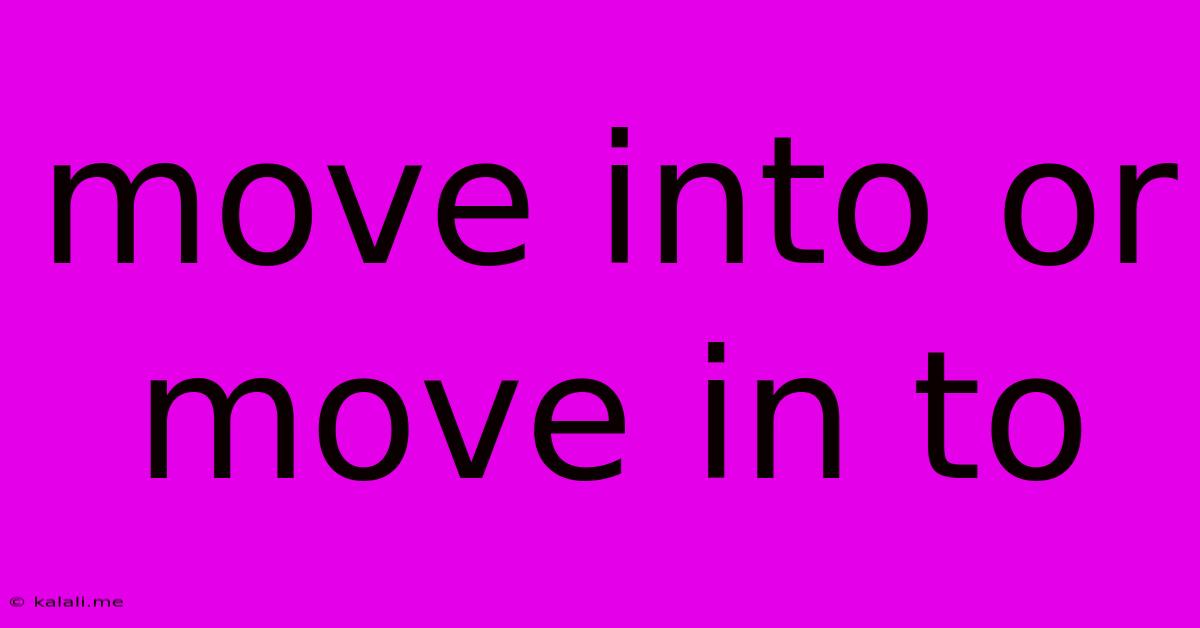Move Into Or Move In To
Kalali
Jun 03, 2025 · 2 min read

Table of Contents
Move Into vs. Move In To: Understanding the Difference
Choosing between "move into" and "move in to" can be surprisingly tricky, even for native English speakers. This article will clarify the difference between these two phrases, helping you choose the correct one in your writing and avoid common grammatical errors. This guide will cover the nuances of both phrases, providing examples to illustrate their proper usage and ensuring you confidently use these phrases in your writing.
The Core Difference: Phrasal Verb vs. Prepositional Phrase
The key lies in understanding that "move into" is a phrasal verb, while "move in to" is a prepositional phrase. This distinction impacts their grammatical function and meaning.
Move Into: A Phrasal Verb
"Move into" acts as a single, inseparable unit. It means to begin living in a new place. It's a concise and commonly used expression.
- Examples:
- "We're excited to move into our new house next month."
- "She decided to move into a smaller apartment."
- "After graduating, he moved into a shared apartment downtown."
Move In To: A Prepositional Phrase
"Move in to" consists of the verb "move in" followed by the preposition "to" introducing a following phrase. This construction is less common and often feels awkward. It's used when "to" introduces a further description or action related to moving in.
- Examples (where "move in to" might possibly be used, though often awkwardly):
- "He moved in to immediately begin renovations." (This is grammatically correct but less concise than "He moved in to begin renovations immediately.")
- "She moved in to a house specifically designed for accessibility needs." (Again, more natural to say "She moved into a house...")
When to Use Each:
In most cases, "move into" is the correct and preferred choice. It's simpler, more direct, and flows better in sentences. Use "move in to" only when you need the preposition "to" to introduce a dependent clause describing the action or purpose immediately following the act of moving in. Even then, carefully consider rephrasing for better clarity and flow.
Common Mistakes to Avoid:
The most common mistake is using "move in to" when "move into" is appropriate. This often leads to clunky and grammatically unnecessary phrasing. Always strive for conciseness and clarity in your writing.
Improving Your Writing with Precise Language:
Using the correct phrasal verb strengthens your writing by conveying meaning accurately and efficiently. Mastering the subtle differences between similar phrases enhances your overall writing style, making it more professional and polished. Choosing the right phrasing avoids ambiguity and leaves a positive impression on your readers.
Conclusion:
While both phrases might appear similar at first glance, understanding their grammatical functions clarifies their appropriate usage. In the vast majority of cases, "move into" is the correct and more natural choice. Remember to choose your words carefully to ensure clarity and precision in your writing. By understanding the difference between “move into” and “move in to,” you can refine your writing and avoid common grammatical errors.
Latest Posts
Latest Posts
-
The Strong Bodies Charge On Credit Card
Jun 05, 2025
-
What Does Blue Mean In The Bible
Jun 05, 2025
-
Standard Height For Closet Shelf And Pole
Jun 05, 2025
-
How To Say Orders Ship At Next Delivery Cycle
Jun 05, 2025
-
How Do You Repair A Leaking Shower Faucet
Jun 05, 2025
Related Post
Thank you for visiting our website which covers about Move Into Or Move In To . We hope the information provided has been useful to you. Feel free to contact us if you have any questions or need further assistance. See you next time and don't miss to bookmark.